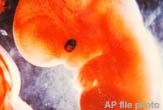Scientists Make Stem Cells Without Harming Embryos

By using single cells plucked from human embryos, scientists have grown human embryonic stem cells, which can turn into any other kind of cell in the body, while leaving the original embryo intact.
This new technique could potentially allow researchers to generate human embryonic stem cells for therapies and further experiments while avoiding the highly controversial destruction of human embryos required to grow the cells the conventional way.
In addition, the method the scientists used to pluck cells out is already routinely practiced during in vitro fertilization to scan embryos for genetic diseases. This procedure does not harm the embryo's further development.
The researchers at Advanced Cell Technology at Worcester, Mass., coaxed the human embryonic stem cells to become a number of potentially therapeutic cell types. These include blood vessel cells that could help mend hearts after heart attacks, and eye cells "that could help rescue visual function," cell biologist Robert Lanza, Advanced Cell Technology's vice president of research and scientific development, told LiveScience.
With permission, Lanza and his colleagues experimented on 16 unused embryos produced over the course of in vitro fertilization attempts. The researchers used micro-eyedroppers to remove single cells from early-stage embryos, each embryo consisting of only eight to 10 cells.
Using these extracted cells, the scientists generated two stable human embryonic stem cell lineages, capable of replicating for months on end and developing into other cell types.
More research is needed to determine if these new embryonic stem cells behave the same as other human embryonic stem cells, which conventionally are derived from a slightly later stage in embryonic development.
Sign up for the Live Science daily newsletter now
Get the world’s most fascinating discoveries delivered straight to your inbox.
Lanza and his colleagues report their findings online Aug. 23 via the journal Nature.
While these experiments still need to get reproduced by others to show the findings stand up, "this is a good example of solid work," Alberto Hayek at the Whittier Institute for Diabetes in San Diego told LiveScience. He added the main issue now is how similar or different the cells generated by this method are to other human embryonic stem cells researchers have been working with.
- Sperm Cells Turned into Eggs
- Scientists Turn Stem Cells Into Neurons
- Partly Human Organs in a Flock of Smelly Sheep
- Harvard Researchers to Clone Human Embryos
- Stem Cells in Lab Make Sperm










